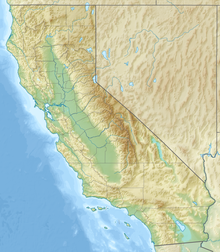Mount Hamilton (California)
-q1VgZFBE93f3hVoav8fAExtsQV25ps)
Mount Hamilton (California)
-q1VgZFBE93f3hVoav8fAExtsQV25ps)
| Mount Hamilton | |
|---|---|
| Sierra de Santa Isabel[1] | |
| Highest point | |
| Elevation | 4,265 ft (1,300 m) NAVD 88[2] |
| Prominence | 93 ft (30 m) [3] |
| Coordinates | 37°20′30.2″N 121°38′34.2″W [32][2] |
| Geography | |
| Location | Santa Clara County, California, U.S. |
| Parent range | Diablo Range |
| Topo map | USGS Lick Observatory |
| Geology | |
| Age of rock | Upper Cretaceous |
| Climbing | |
| First ascent | 1861 |
| Easiest route | Hike |
Mount Hamilton is a mountain in California's Diablo Range, in Santa Clara County, California. Mount Hamilton, at 4,265 feet (1,300 m) is a mountain overlooking Santa Clara Valley and is the site of Lick Observatory, the World's first permanently occupied mountain-top[4] observatory.[5] The asteroid 452 Hamiltonia, discovered in 1899, is named after the mountain. Golden eagle nesting sites are found on the slopes of Mount Hamilton. On clear days, Mount Tamalpais,[6] the Santa Cruz Mountains, Monterey Bay, the Monterey Peninsula, and even Yosemite National Park are visible from the summit of the mountain.[7][8][9]
| Mount Hamilton | |
|---|---|
| Sierra de Santa Isabel[1] | |
| Highest point | |
| Elevation | 4,265 ft (1,300 m) NAVD 88[2] |
| Prominence | 93 ft (30 m) [3] |
| Coordinates | 37°20′30.2″N 121°38′34.2″W [32][2] |
| Geography | |
| Location | Santa Clara County, California, U.S. |
| Parent range | Diablo Range |
| Topo map | USGS Lick Observatory |
| Geology | |
| Age of rock | Upper Cretaceous |
| Climbing | |
| First ascent | 1861 |
| Easiest route | Hike |
History
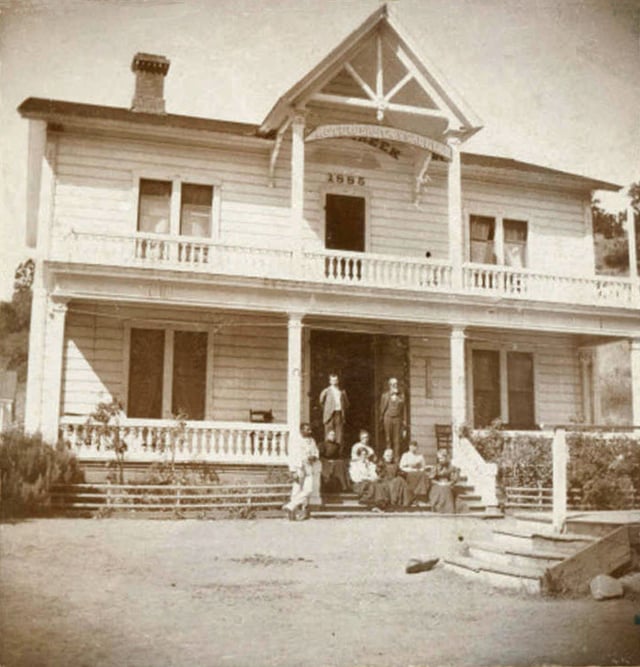
Hotel Santa Ysabel on the road up Mt. Hamilton just across Smith Creek in 1895, Courtesy of San Jose Public Library, California Room
On August 26, 1861, while working for Josiah D. Whitney on the first California Geological Survey, William H. Brewer invited local San Jose preacher (and Brewer's personal friend) Laurentine Hamilton to join his company on a trek to a nearby summit. Nearing completion of their journey, Hamilton, in good humor, bounded for the summit ahead of the rest of the men and claimed his stake. In fact, Brewer suggested the mountain be named after Hamilton, only after Whitney declined to have the mountain named after him (a different mountain was later named Mount Whitney).
The Spanish name for Mt. Hamilton was the Sierra de Santa Isabel and the highest point was originally known as Mount Isabel instead of Mount Hamilton. William Henry Brewer and his fellow geologist, Charles F. Hoffmann, did not know it already had a name, and named it Mt. Hamilton, although they did place Isabel Valley on their map to the east. The "Hotel Santa Ysabel" was built on the road up the mountain in 1885 on Smith Creek.[10] When in 1895, the USGS realized that the peak two miles southeast of Mt. Hamilton was as tall (4,193 ft or 1,278 m),[11] they named it Mt. Isabel.[12]
Climate

Numerous times each winter temperatures drop low enough for Mount Hamilton (left) to receive as much as a foot of snow for a day or two.
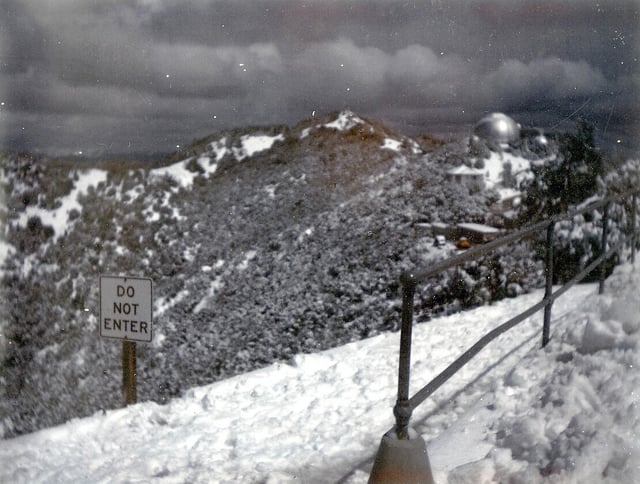
Mt. Hamilton had a foot of snow on the ground on April 1, 1967
These mountains are high enough to receive snowfall in the winter, perhaps up to a dozen times. Occasionally, when a cold, wet storm comes in from the Gulf of Alaska or Canada, Mt. Hamilton and the surrounding peaks get significant snowfall. In February 2001, 30 inches (76 cm) of snow fell, and in March 2006, the peak was left with over a foot (30 cm) of snow in one night.
The National Weather Service has had a cooperative weather station on the summit of Mount Hamilton almost since the time that the Lick Observatory opened. It has provided a glimpse of the extreme weather conditions that occur on the Diablo Range, especially in the winter months.
January is usually the coldest month on Mount Hamilton with an average high of 49.4 °F (9.7 °C) and an average low of 37.5 °F (3.1 °C). The warmest month is usually July with an average high of 78.2 °F (25.7 °C) and an average low of 63.1 °F (17.3 °C). Due to frequent thermal inversions during the summer, it is often warmer on Mount Hamilton than in San Jose. The record high temperature of 103 °F (39 °C) was on August 5, 1978. The record low temperature of 7 °F (−14 °C) was on December 21, 1990. The average days with highs of 90 °F (32 °C) or higher is 4.3 days. The average days with lows of 32 °F (0 °C) or lower is 50.6 days.
Annual precipitation averages 23.73 inches (603 mm). Measurable rainfall occurs on an average of 71.9 days each year. The most rainfall in a month was 12.13 inches (308 mm) in February 1998; no rainfall has been common during the summer months. The maximum rainfall in 24 hours was 6.87 inches (174 mm) on December 23, 1955.
Annual snowfall averages 10 inches (25 cm). The maximum snowfall in a year was 59.0 inches (150 cm) in 1955. The maximum snowfall in a month was 38.1 inches (97 cm) in February 2019[13]. The 24-hour maximum snowfall of 14.0 inches (36 cm) occurred on February 18, 1990. The deepest daily snow depth was 18 inches (46 cm) in March 1976. Measurable snow has been recorded in every month from November through June.[14]
| Climate data for Mount Hamilton, California (Station Elevation 4,206ft) | |||||||||||||
|---|---|---|---|---|---|---|---|---|---|---|---|---|---|
| Month | Jan | Feb | Mar | Apr | May | Jun | Jul | Aug | Sep | Oct | Nov | Dec | Year |
| Record high °F (°C) | 73 (23) | 78 (26) | 77 (25) | 84 (29) | 91 (33) | 94 (34) | 100 (38) | 103 (39) | 98 (37) | 93 (34) | 81 (27) | 76 (24) | 103 (39) |
| Average high °F (°C) | 48.5 (9.2) | 49.0 (9.4) | 50.1 (10.1) | 55.3 (12.9) | 63.1 (17.3) | 71.4 (21.9) | 78.7 (25.9) | 78.0 (25.6) | 74.2 (23.4) | 65.3 (18.5) | 54.8 (12.7) | 49.0 (9.4) | 61.4 (16.3) |
| Average low °F (°C) | 36.8 (2.7) | 36.7 (2.6) | 36.7 (2.6) | 39.6 (4.2) | 46.3 (7.9) | 54.4 (12.4) | 63.3 (17.4) | 62.5 (16.9) | 58.4 (14.7) | 50.7 (10.4) | 42.1 (5.6) | 37.1 (2.8) | 47.1 (8.4) |
| Record low °F (°C) | 10 (−12) | 13 (−11) | 17 (−8) | 19 (−7) | 25 (−4) | 28 (−2) | 34 (1) | 37 (3) | 35 (2) | 20 (−7) | 18 (−8) | 7 (−14) | 7 (−14) |
| Average precipitation inches (mm) | 4.43 (113) | 3.92 (100) | 3.49 (89) | 2.04 (52) | 0.84 (21) | 0.20 (5.1) | 0.03 (0.76) | 0.07 (1.8) | 0.27 (6.9) | 1.23 (31) | 3.07 (78) | 4.04 (103) | 23.63 (600) |
| Average snowfall inches (cm) | 5.0 (13) | 3.9 (9.9) | 3.8 (9.7) | 2.3 (5.8) | 0 (0) | 0 (0) | 0 (0) | 0 (0) | 0 (0) | 0 (0) | 0.4 (1.0) | 2.3 (5.8) | 17.7 (45) |
| Source: The Western Regional Climate Center[15] | |||||||||||||
Geography
Copernicus Peak
Mount Hamilton is one summit along a mile-long ridge. Other than Hamilton, peaks along the ridge have astronomical names, such as Kepler. The highest peak on the ridge is Copernicus Peak, with elevation 4,360+ ft (1,330+ m).[16][17] Copernicus Peak is located 0.8 miles (1.3 km) to the northeast from Mount Hamilton, and is the highest point in Santa Clara County.[18] Unlike Mount Hamilton's limited prominence, Copernicus Peak has a prominence of 3,080 ft (940 m).[16]
Mount Hamilton Road
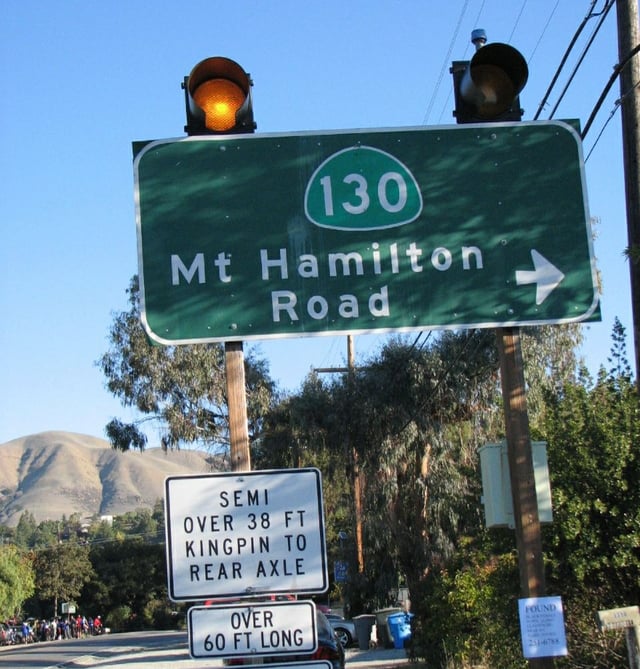
State Route 130 begins its ascent from the junction at Alum Rock Road.
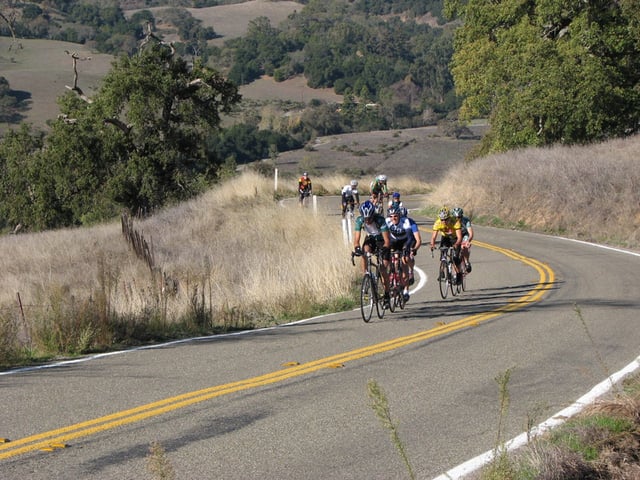
Cyclists above Grant Ranch.
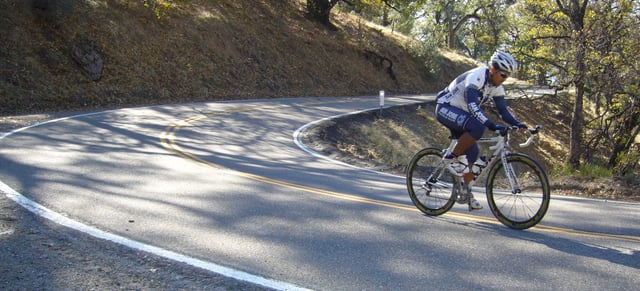
Mt. Hamilton Road is popular with cycling clubs.
The sinuous 19-mile (31 km) Mt. Hamilton Road (part of State Route 130) is commonly used by bicyclists and motorcyclists. Built in 1875–76 in anticipation of the observatory, and the need to carry materials and equipment up the mountain in horse-drawn wagons, the grade seldom exceeds 6.5 percent. The road rises over 4,000 feet (1,200 m) in three long climbs from San Jose to the mountain top. On a clear day at the summit it is possible to see the Sierra Nevada.
Cyclists commonly use the road because of the long but not overly challenging nature of the climb, sparse vehicular traffic over most of its length, and the views of San Jose and the Santa Clara Valley below. There is an annual cycling challenge climb in April.[19] Thanksgiving consistently draws hundreds of cyclists and is frequently the final climb in the annual Low-Key Hillclimb Series[20] which attracts some of the region's best climbers.
The bicycle ride is just over 19 miles (31 km) from the Alum Rock Road junction. The upward trek is interrupted by two descents, first into Grant Ranch County Park, and again to cross Smith Creek. Quimby Road offers a shorter way from San Jose to Grant Ranch, but is considerably steeper. The main observatory building has water, a few vending machines, restrooms, and an opportunity to warm up on a cold day. If the time is right, there are also free 15-minute guided tours of the Great Lick refracting telescope, and the gift shop may be open.
Geology and hydrology
Much of the foothill slopes of Mount Hamilton is underlain by Miocene age sandstone of the Briones formation: this bedrock is locally soft and weathered in the upper few feet, but grades locally to very hard at depth. Depth to groundwater on these foothill areas of Mount Hamilton is approximately 240 feet (73 m).[21] The Babb Creek drainage comprises some of the watershed draining the slopes of Mount Hamilton. The Calaveras and Hayward active earthquake faults traverse the slopes of Mount Hamilton.
Ecology and conservation
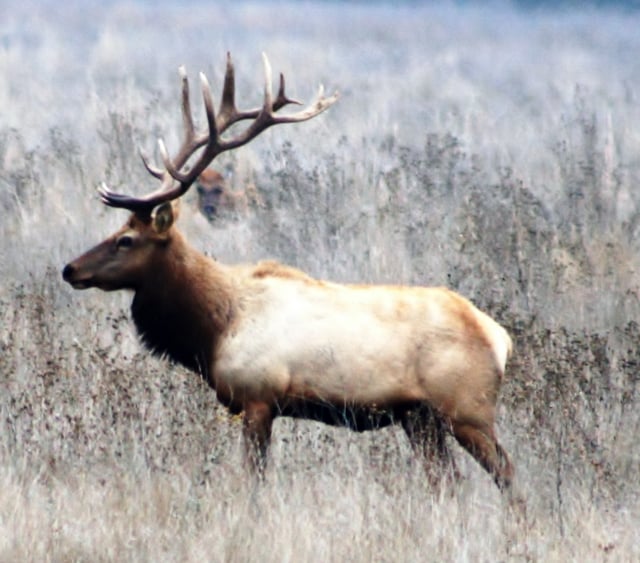
Tule elk roam the Diablo Range and are often seen on Coyote Ridge
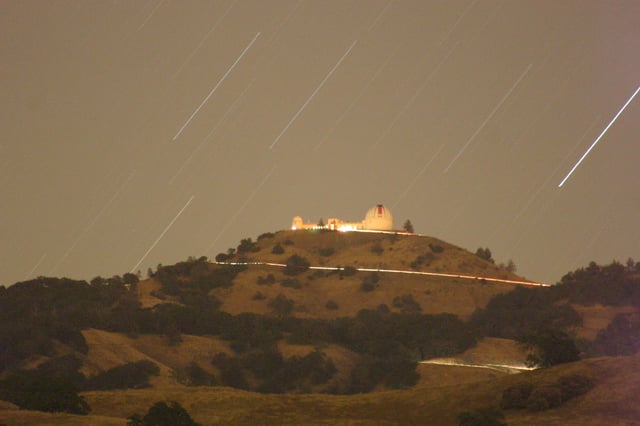
Lick Observatory on Mount Hamilton at night. Timed exposure taken from Grant Ranch Park.
Several rare species can be seen on Mount Hamilton. The Mount Hamilton jewelflower (Streptanthus callistus) is endemic to the area. In June 2011, five juvenile California condors flew over Mt. Hamilton and landed on the Lick Observatory, the species' first sighting in the area in at least 30 years.[22]
In 1978, California Department of Fish and Game warden Henry Coletto urged the department to choose the Mount Hamilton area as one of California's relocation sites under a new statewide effort to restore tule elk (Cervus canadensis ssp. nannodes).
The community
See also
List of highest points in California by county
List of summits of the San Francisco Bay Area
Grant Ranch Park
